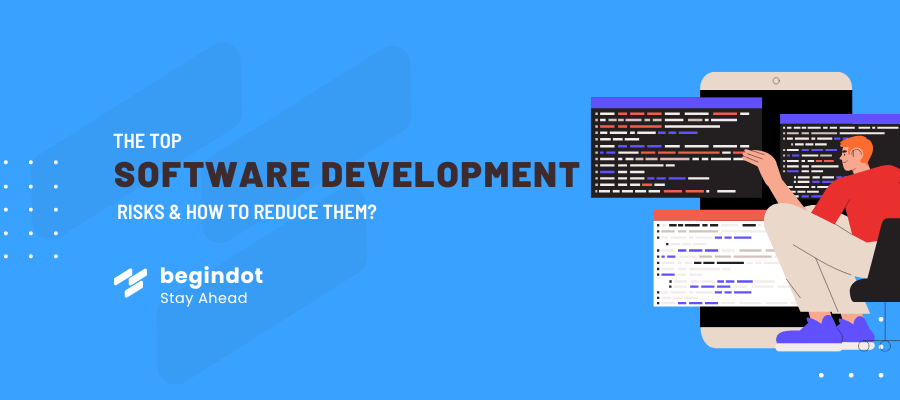Software development is not just about writing code: there are plenty of other factors that come into play during the development process.
It doesn’t matter how you are planning to bring your project to life, by resorting to custom software product development services or by delegating the project to your internal team, you can’t avoid each risk of software development.
What you certainly can do, is reduce some of the potential risks.
In order to help you reduce these risks, we have put together this list of ten common issues that affect software projects.
In this article, you will find out not only about them but also about the ways to mitigate them. So keep on reading!
What are the common risks in software development?
Software development risks are factors that can influence your software project in a negative way. It’s important to identify and mitigate these risks before they cause big problems. They can occur both externally and internally.
So, what are the risks in software development?
Unclear Expectations
Unclear expectations are a common risk in software development projects. Nearly 37% of projects fail because of unclear goals.
If you are not certain about what you are aiming for, or if you, your partner, and your team have different ideas about the goals of your project and different visions for the future of your product, then it’s likely that you will end up spending more time and resources than necessary.
How to reduce the risk: it’s important to manage your expectations early in the project. You can do this by setting up meetings with key stakeholders throughout all phases of your project, including planning meetings where everyone agrees on how the future product should look; kickoff meetings where new team members meet with their colleagues; conducting review sessions after each major phase concludes.
Poorly Defined Requirements
Requirements are an important part of the software development process, and having a well-organized product development team is crucial for success. 35% of projects fail because the development team isn’t aware of the exact software requirements.
The creation of clear requirements involves collecting information about what you want your software to do, and organizing it into a format that can be used by developers, testers, and stakeholders.
This format is called an SRS (Software Requirements Specification) document. However, even with a clear SRS document, if the product development team is not working effectively together, it may lead to project failure or the need to rework the product from scratch when it’s close to the final phase.
How to reduce the risk: it’s important to establish a strong product development team that communicates well and is able to identify and mitigate risks. This includes ensuring that everyone on the team knows what they are doing, and that there is a clear plan in place for avoiding potential pitfalls.
By doing so, you can minimize misunderstandings and avoid unnecessary rework, ultimately leading to a successful software product development project.
Security Threats
Security risks in software engineering are always a big concern. They can be divided into external and internal ones.
- External risks include hacking, intellectual property stealing, and everything associated with cybercriminals getting access to your database. This may happen if developers use suspicious services, tools, and technologies during the development process.
- Internal risks are related to possible leaks of information and sensitive data due to the fault of the specialists working on the project. This may happen on purpose or by accident.
How to reduce the risk: make sure that no one in your team uses services, tools and technologies that don’t inspire 100% confidence; sign an NDA (Non-disclosure agreement) with anyone who will work on your project, be it an in-house worker or freelancer. This will prevent an unwanted information leak.
Problems with quality assurance
Testing is a critical part of any software development project. Testing ensures that your product meets the initial requirements and doesn’t have any bugs or errors, being able to ensure smooth and trouble-free performance for the users.
But sometimes, testing goes the wrong way. This may happen due to the incorrectly chosen testing techniques, not enough time dedicated to testing, QA engineers not having enough experience or skills, etc.
How to reduce the risk: testers and developers should communicate regularly during the development process to be able to quickly fix all issues before they turn into real trouble. In short, developers create the code while testers validate it.
Testing should be performed in parallel with development so that invalidated code created during one stage of the development process wasn’t incorporated into the next stage of the development process. Testers that you hire for your project should have the corresponding skills and experience to get the job done well.
Poorly Designed UI/UX
Poorly designed UI/UX is one of the top project risks that software development teams face. Usually, the design process is done badly because the team doesn’t devote enough time to it managing other development tasks instead.
It’s not just the design itself that can cause problems, but also how it’s implemented and maintained over time. Compromising design can become a reason for user frustration which can potentially lead to a decrease in revenue for your company.
Poorly thought-out user experience (UX) also makes it harder for users to get things done quickly, driving them away from your product or service.
How to reduce the risk: the best way to ensure that your design is convenient and user-friendly is to establish regular communication between your designers and developers. The design should be done into several iterations until it will be 100% confirmed by everyone involved.
Overlooking Future Growth
After the product is launched on the market, it’s only the beginning of its way on the market. It’s extremely important to think about the future of your product as the number of your users will grow as well as their demands.
New competitors will also appear on the market. And if you are not ready for that, your initially successful startup may crash.
How to reduce the risk: it’s important to plan the future of your product right from the start. Of course, you should upgrade and improve your product basing on customer response, but it’s important to have a clear vision of the product’s future as you plan the development process.
Operational risks
Operational risks in software development refer to the risks that happen during the everyday activities of the development process. This may include conflicts between team members, improper management of tasks, absence of a clear development plan, lack of communication, unstable workload, etc.
How to reduce the risk: In order to reduce operational risks, you need to make sure that you have a project management strategy and an established development plan.
It’s also important to ensure that all the team members have established communication: this will reduce conflicts, misunderstandings, and delays in task accomplishment, and will contribute to the quick resolution of issues.
Coding Issues
Code is the heart of your product that makes all things work. It also makes your project unique and valuable.
So, poor quality of code can result in really serious problems like bugs, errors, and others. There are a lot of factors that can affect code quality: lack of developers with the needed skills, aggressive deadlines, etc.
How to reduce the risk: in order to mitigate risks associated with code, test the code as frequently as you can. Fix bugs and errors as soon as they are spotted. Define code standards for developers in an SRS document.
Deadline Issues
Schedule risks in software development are quite a sensitive topic. They can postpone your project, or result in a poor-quality product being launched.
Sometimes, a development team just fails to meet these deadlines if they are too strict. Or, on the contrary, incorrect deadlines may lead to a waste of valuable time and budget risks.
How to reduce the risk: when you start creating a development plan, pay attention to the establishment of deadlines. Define time frames for each stage/iteration of the development process.
Consider your resources (specialists, money) – they are the main factor influencing the time required to get your project done.
Low productivity
Even if you have calculated everything right, and created a comprehensive and detailed development plan, the low productivity of your team may overtake you at the most unexpected moment and become an unpleasant surprise.
This may happen due to a bunch of reasons: low motivation of workers, unclear goals, absence of progress, poor productivity management, non-established communication between team members (the Project Management Institute estimated that around 30% of projects fail due to poor communication), etc.
How to reduce the risk: define clear goals for the team members, make sure that the working process is balanced, and no one has too many or too few tasks to do and find the right project manager that can bring the whole team together around your project.
Conclusion
Software development project involves many different parties, each with its own needs and expectations. The key to success is to understand these needs and manage them effectively so that they don’t get in the way of your project’s progress.
It’s important to keep in mind that software development is a complex process, and it’s impossible to avoid every risk. The Standish Group’s 2020 CHAOS report estimates that around 66% of software projects fail because they are unable to fight these risks.
However, by being aware of the top risks and knowing how to reduce them, you can decrease the possibility of this happening.








